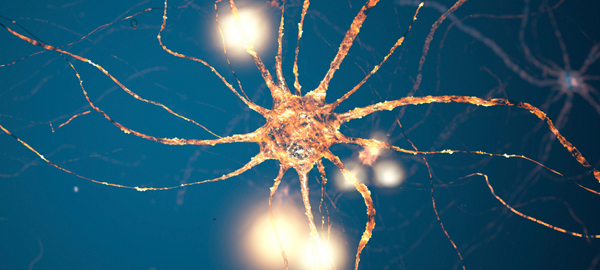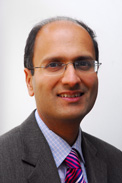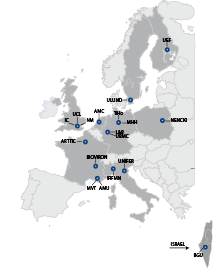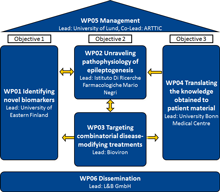Partner 7 - University College London
EPITARGET Team UCL
Institute presentation
The UCL Institute of Neurology (![]() ION) is the UK’s leading neurological institute, with the greatest concentration of neuroscience researchers in the UK. ION is a multidisciplinary neuroscience research facility. The ION Department of Clinical and Experimental Epilepsy (
ION) is the UK’s leading neurological institute, with the greatest concentration of neuroscience researchers in the UK. ION is a multidisciplinary neuroscience research facility. The ION Department of Clinical and Experimental Epilepsy (![]() DCEE) provides a comprehensive epilepsy service, with >1200 new referrals/year, >8000 patients under follow-up, >50 therapeutic neurosurgical/year. Already existing within DCEE are searchable registries, including of patients in a long-standing genetics study, with >4000 DNA samples, and of patients who have had surgery, and a post-mortem (PM) archive. UCL has a full-equipped neuropathology laboratory, with light, fluorescent, and electron microscopy, and capacity for molecular neuropathology studies. ION has extensive experience of in vivo and in vitro models of epilepsy and seizures. UCL has developed a novel wireless telemetry system with automated seizure detection, for long-term investigation of epilepsy modifying treatments. UCL has facilities for in vitro/in vivo neurophysiology and for monitoring free radical and ATP production, and mitochondrial function.
DCEE) provides a comprehensive epilepsy service, with >1200 new referrals/year, >8000 patients under follow-up, >50 therapeutic neurosurgical/year. Already existing within DCEE are searchable registries, including of patients in a long-standing genetics study, with >4000 DNA samples, and of patients who have had surgery, and a post-mortem (PM) archive. UCL has a full-equipped neuropathology laboratory, with light, fluorescent, and electron microscopy, and capacity for molecular neuropathology studies. ION has extensive experience of in vivo and in vitro models of epilepsy and seizures. UCL has developed a novel wireless telemetry system with automated seizure detection, for long-term investigation of epilepsy modifying treatments. UCL has facilities for in vitro/in vivo neurophysiology and for monitoring free radical and ATP production, and mitochondrial function.
UCL Chemistry is a world-leading Department and has recently invested in state-of-the-art radiochemistry facilities. The radiochemistry group aims to develop new labelling methods, design novel tracers for preclinical and clinical imaging, and to provide radiotracers for biomedical research. The radiochemistry facility has 3 shielded fume hoods and 2 hot cells, as well as automated synthesis modules for 18F-tracer production. Erik Årstad, who leads the UCL Radiochemistry group, has pioneered tracer development for ion-channels (NMDAR, AMPA and VSGCs), and made seminal contributions to labelling methodology for PET ([18F]fluoroethyl azide “click labelling”) and SPECT tracers (three-component iodination chemistry). The radiochemistry group works closely with the UCL Centre for Advanced Biomedical imaging (CABI, Director Mark Lythgoe), which houses 10 modalities for preclinical imaging, including small animal NanoSPECT/CT, PET/CT, 1T MRI and 9.4 T MRI.
Sanjay Sisodiya has published extensively on epilepsy neuropathology, leads epilepsy genetics research at ION/UCL, is the PI on a multicentre Wellcome Trust Genomics of Common Diseases grant that funded the largest genome-wide association study in epilepsy to date, has organised workshops and international conference sessions on epilepsy genomics and was a member of the International League Against Epilepsy Genetics Commission and Neuropathology Task Force on Hippocampal Sclerosis, and currently serves on the International League Against Epilepsy Pharmacogenomics Task Force. Dr Thom is one of a handful of human epilepsy neuropathologists in the world, with an extensive publication record. Matthew Walker has published on clinical & basic science aspects of epilepsy and has huge experience of translational research. He has served on a number of ILAE Commissions and Task forces and is presently Secretary of the Commission of European Affairs and Treasurer of the UK Chapter. He is also Chair of the Joint Epilepsy Council of UK and Ireland. He is an associate editor of Brain. Dr Abramov is an established expert in mitochondrial function and free radical formation in neurological disease.













